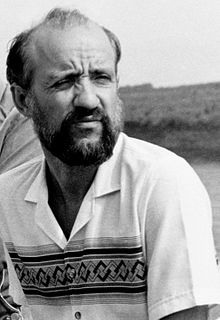Arthur Winfree
Arthur Taylor Winfree (born May 15, 1942 in Saint Petersburg , Florida , † November 5, 2002 in Tucson , Arizona ) was an American theoretical biologist.
Life
Winfree entered the finals of the Westinghouse Science Talent Contest as a student. He studied first as a physics engineer at Cornell University (bachelor's degree in 1965) and then biology at Princeton University , where he received his doctorate in 1970. From 1969 he was Assistant Professor at the University of Chicago , from 1972 Associate Professor of Biology at Purdue University , where he became a professor in 1979. From 1986 he was Professor of Ecology and Evolutionary Biology at the University of Arizona , from 1989 as "Regents Professor".
In 1982 he was a Guggenheim Fellow and from 1984 a MacArthur Fellow . In 2000 he received the Norbert Wiener Prize . In 1989 he received the Dutch Einthoven Prize for his cardiological work.
His son Erik Winfree is a professor at Caltech (specializing in biological information processing) and his daughter Rachel is a professor of entomology at Rutgers University .
plant
Winfree is known for his theory of non-linear coupled oscillators in biology, the theory of biological rhythms and clocks (from the synchronization of crickets chirping to arrhythmias such as ventricular fibrillation ), a field that he largely determined.
In 1965, in his diploma thesis at Cornell University, he investigated the theory of large quantities of weakly coupled nonlinear oscillators, which, because of the weak coupling, only influence each other via their phases in a first approximation. He showed phase transitions to collective behavior (synchronization of the oscillators).
In the late 1960s, he examined ("circadian") rhythms in the populations of fruit flies in his dissertation . His surprising discovery at the time was that such rhythms can be disrupted by weak disturbances if they occur with the correct phase (occurrence of a phase singularity).
In addition, he dealt with other self-organization and pattern formation phenomena in chemistry ( Belousov-Zhabotinsky reaction ) and similar reaction-diffusion equations, which he investigated from the early 1970s, theoretically and experimentally investigating two-dimensional spiral waves , and later also three-dimensional snails (Scroll) waves. In biology, for example, he investigated the self-organization in slime mold colonies . As in his work on biological rhythms, he was often guided by “simple” topological considerations.
Fonts
- Sudden cardiatic death - a problem in topology ?, Scientific American May 1983
- Geometry of Biological Time, Springer 1980, 2nd edition 2001
- When time breaks down: the three dimensional Dynamics of Electrochemical Waves and Cardiac Arrythmias, Princeton University Press 1987
- Biological clocks - Time structures of the living, Spektrum Verlag 1988 (English original: Timing of biological clocks, Scientific American Library, Freeman, 1987)
literature
- John Tyson, Leon Glass: Obituary in Journal of Theoretical Biology, Vol. 230, 2004, p. 433, online here PDF file
Web links
Individual evidence
- ↑ Winfree, Biological rhythms and the behavior of populations of coupled oscillators, Journal of Theoretical Biology, Vol. 16, 1967, pp. 15-42
- ↑ Winfree, Integrated view of the resetting of a biological clock, Journal of Theoretical Biology, Vol. 28, 1970, pp. 327-374
- ↑ Winfree: Spiral waves of chemical activity, Science, Vol. 175, 1972, pp. 634-636
- ↑ Winfree: "Scroll shaped waves of chemical activity in three dimensions", Science Vol. 181, 1973, p. 634, Strogatz, Winfree: Organizing centers for three-dimensional chemical waves, Nature, Vol. 311, 1984, p. 611 –615, as well as a series of works with Strogatz Singular filaments organize chemical waves in three dimensions , Physica D, 1982 to 1984
- ↑ there the problem was still one-dimensional, with circular images
| personal data | |
|---|---|
| SURNAME | Winfree, Arthur |
| ALTERNATIVE NAMES | Winfree, Arthur Taylor (full name) |
| BRIEF DESCRIPTION | American theoretical biologist |
| DATE OF BIRTH | May 15, 1942 |
| PLACE OF BIRTH | Saint Petersburg , Florida |
| DATE OF DEATH | November 5, 2002 |
| Place of death | Tucson |
